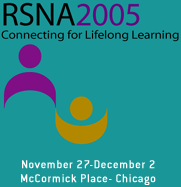
Abstract Archives of the RSNA, 2005
Ryan C Lipscomb BS, Presenter: Nothing to Disclose
Elizabeth Alina Sadowski MD, Abstract Co-Author: Nothing to Disclose
Bryan N Becker MD, Abstract Co-Author: Nothing to Disclose
Arjang Djamali MD, Abstract Co-Author: Nothing to Disclose
Thomas Martin Grist MD, Abstract Co-Author: Nothing to Disclose
Sean B. Fain PhD, Abstract Co-Author: Nothing to Disclose
Our study aims to determine if magnetic resonance (MR) measurements of intrarenal perfusion may be used to differentiate between normal functioning renal allografts, those with acute tubular necrosis (ATN), and those with acute rejection. To date there has only been a qualitative assessment of enhancement, with no reports of the quantitative differences in blood flow in poorly functioning human allografts (Szolar et al. Mag Res Imaging 1997;15:727).
Fourteen subjects with recently transplanted kidneys (less than 4 months), were enrolled in this IRB approved study. Five subjects had clinically normal functioning allografts (N = 5). In the remaining subjects, either ATN (N = 3) or acute rejection (N = 6) was present, which was verified by clinically indicated biopsy. MR perfusion imaging (1.5T GE medical systems) was performed within 48 hours of biopsy, using echo planar, T2*-weighted perfusion sequence with a contrast injection of 0.1 mmol/kg gadodiamide (Omniscan, GE Healthcare, Princeton, NJ). During the acquisition, the subjects held their breath for 30 seconds, followed by 150 seconds of free breathing. Parameters: TR/TE/flip = 1000ms/30ms/60°, FOV = 340 x 340 mm, matrix = 128 x 64, slice thickness = 10 mm. Temporal resolution = 1.0 second. The cortical blood flow was calculated off-line using dedicated software and employing indicator dilution methods.
The cortical blood flows were significantly lower in the acutely rejecting allografts (363ml/100g/min ±66; p < 0.05), than in those with ATN (599ml/100g/min ±163) or normal function (594ml/100g/min ±92). There was no statistical difference in cortical blood flow between ATN and normal function. An increased mean transit time (MTT) was observed in the acute rejection group (MTT = 11.6sec ±6.5)), compared with both ATN (MTT = 5.6sec ±2.0) and normal functioning groups (MTT = 6.9sec ±3.2).
MR perfusion techniques demonstrate significantly diminished cortical perfusion in those allografts with acute rejection compared to those exhibiting either normal function or ATN. MRI may provide a non-invasive method for evaluating physiologic patterns of allograft function in humans.
Lipscomb, R,
Sadowski, E,
Becker, B,
Djamali, A,
Grist, T,
Fain, S,
Quantitative MR Measures of Renal Cortical Perfusion in the Assessment of Acute Rejection. Radiological Society of North America 2005 Scientific Assembly and Annual Meeting, November 27 - December 2, 2005 ,Chicago IL.
http://archive.rsna.org/2005/4414274.html

